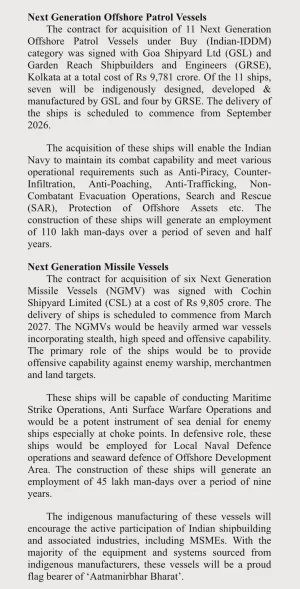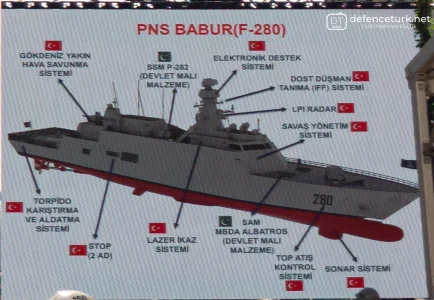- Joined
- Jul 15, 2024
- Messages
- 240
- Likes
- 1,253
The 26/11 terror attack and multiple incidents of ships drifting undetected near Indian shores reinforced the belief that the vast 7500km Indian coastline is vulnerable to foreign intrusions.
To combat such threats the importance of OPVs has grown manifold.
While frigates form the bedrock of a fleet and are the principal surface combatants in many small to medium navies, OPVs have carved out their own niche because of the range of options they provide which makes them extremely cost effective force multipliers for a range of operations.
OPVs are long range surface ships, capable of operation in maritime zones of India, including island territories. Their roles include coastal and offshore patrolling, policing maritime zones of India, control and surveillance, anti-smuggling and anti piracy missions with limited wartime roles.
OPVs can be broadly classified into two types. Firstly, high-end war-fighting vessels with expensive weapon systems and C4I suites and Secondly the more basic patrol vessels, designed for sustained low intensity missions with basic gun armaments, standard navigation sensors and built to commercial standards.
Indian Navy's upcoming Next Generation Offshore Patrol Vessel or NGOPV for short come under the second type and are meant for search and rescue (SAR), counter-narcotics, humanitarian operations and exclusive economic zone (EEZ) patrol.
A total of 11 NGOPV's are to be built by Indian shipyards under the IDDM category.
The deal was signed on 30 March 2023 with the deliveries scheduled to commence from September 2026.
Source: Indian Navy RFI
To combat such threats the importance of OPVs has grown manifold.
While frigates form the bedrock of a fleet and are the principal surface combatants in many small to medium navies, OPVs have carved out their own niche because of the range of options they provide which makes them extremely cost effective force multipliers for a range of operations.
OPVs are long range surface ships, capable of operation in maritime zones of India, including island territories. Their roles include coastal and offshore patrolling, policing maritime zones of India, control and surveillance, anti-smuggling and anti piracy missions with limited wartime roles.
OPVs can be broadly classified into two types. Firstly, high-end war-fighting vessels with expensive weapon systems and C4I suites and Secondly the more basic patrol vessels, designed for sustained low intensity missions with basic gun armaments, standard navigation sensors and built to commercial standards.
Indian Navy's upcoming Next Generation Offshore Patrol Vessel or NGOPV for short come under the second type and are meant for search and rescue (SAR), counter-narcotics, humanitarian operations and exclusive economic zone (EEZ) patrol.
A total of 11 NGOPV's are to be built by Indian shipyards under the IDDM category.
The deal was signed on 30 March 2023 with the deliveries scheduled to commence from September 2026.
| Type | Offshore Patrol Vessel |
| Place of Origin | India |
| Service History | Under Construction |
| Used By | Indian Navy |
| Unit Cost | 110 million Dollars |
| Ships Planned | 11 |
| Manufacturer | • Goa Shipyard (GSL) • Garden Reach Shipbuilders & Engineers (GRSE) |
| Displacement | 2500 tons |
| Length | 105 - 110 m |
| Beam | - |
| Draught | 5 m |
| Propulsion | 2 × Diesel Engine with Controlled Pitch Propellers and Twin Rudders (Unknown Supplier) |
| Speed | 25 kn (maximum) 20 kn (sustained) 14 kn (economical) |
| Range | 8500 nm (on economical speed of 14 kn) |
| Endurance | 60 days at Sea |
| Sea Worthiness | • Operational Role – upto Sea State 5 • Heli Operations – upto Sea State 4. • Survivability – upto Sea State 8. |
| Ship Life | 30 years |
| Personnel | 20 officers and 130 sailors |
| Sensors | • 2 x BEL LynxU2 • 2 x EOIRST • 1× Navigation Radar (Unknown Supplier) |
| Management System | • Indigenous CMS (Combat Management System) • Integrated Platform Management System (IPMS) • Integrated Machinery Control System (IMCS) • Automatic Power Management System (APMS) • Battle Damage Control system (BDCS) |
| Electronic warfare Suite | • 1 x Kavach decoy launchers • 1 x Maareech torpedo countermeasure systems • 1 x XBT • 2 x Acoustic Warning Device • Indigenous ESM system |
| Armament | • 1 × 76 mm Oto Melara gun • 2 × 30mm AK-630CIWS • 2 x VSHORADS • 2 x 12.7 mm Elbit SRCG • Naval Mines (Modular) • Heli Launched Shyena Torpedo • Heli Launched NASM SR Anti Ship Missile |
| Aviation | • 1 × 15 t helicopter (HAL Dhruv or MH-60R) • VTOL UAVs |
| Boats | 2 × 7m Rigid Hull Boats |
Source: Indian Navy RFI





